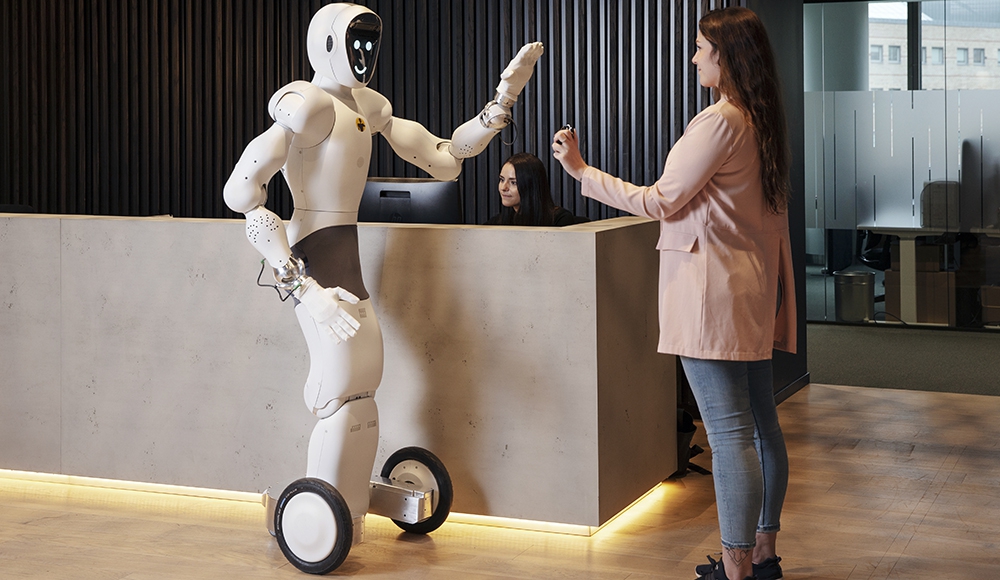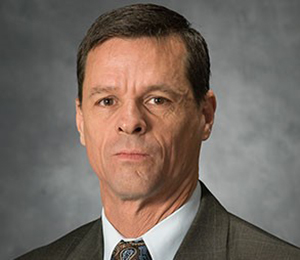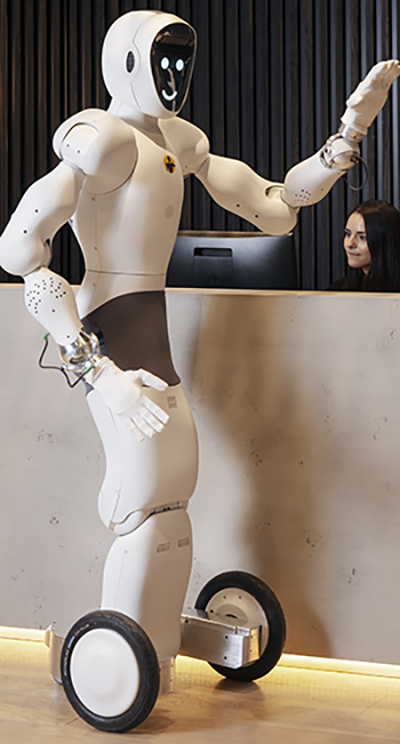ADT Commercial introduces humanoid robotics to security industry Innovation Lab’s first endeavor incorporates robots into commercial security space

By Cory Harris, Editor
Updated 12:16 PM CST, Wed December 1, 2021

DALLAS—ADT Commercial prides itself on delivering innovative commercial security, fire, life safety and risk consulting solutions for its customer base throughout the United States.
That focus on innovative solutions, even in the midst of the COVID-19 pandemic, has led to ADT Commercial’s recent establishment of its own Innovation Lab, and the lab’s initial endeavor – the introduction of humanoid robotics into the commercial security space.
 Dan Bresingham, Executive Vice President for ADT Commercial, told Security Systems News that the recently formed Innovation Lab is based in Dallas, Texas, in the company’s National Accounts Operations Center (NAOC), where ADT Commercial takes care of a lot of its customers, including national accounts.
Dan Bresingham, Executive Vice President for ADT Commercial, told Security Systems News that the recently formed Innovation Lab is based in Dallas, Texas, in the company’s National Accounts Operations Center (NAOC), where ADT Commercial takes care of a lot of its customers, including national accounts.
“We formed the Innovation Lab with a group called the Enterprise Services Risk Group [eSRG], a very talented group of individuals with a very unique background in our space,” he explained. “These individuals represent a lot of military leadership, former CSOs from big organizations, and an ex-FBI agent. The group is headed up by Ed Bacco, eSRG Vice President at ADT Commercial and a former CSO at Amazon.
“That group really got us thinking about ‘Hey, how do we get more innovative as a company, and can we do partnerships with companies and come up with new products and services?’”
Chris Fowler, Director of Emerging Technologies for ADT Commercial and also a member of the eSRG, noted that he spent 26 years in the Seattle Police Department, retiring as Deputy Chief, concurrently serving 30 years in the U.S. Army National Guard, retiring as a brigadier general.
 “On the police side, I worked closely with a lot of Fortune 100 companies that are based in Seattle and understanding what their security needs are, both from a law enforcement standpoint and looking at what their security operations were concerned about - what they needed and what was available to them.
“On the police side, I worked closely with a lot of Fortune 100 companies that are based in Seattle and understanding what their security needs are, both from a law enforcement standpoint and looking at what their security operations were concerned about - what they needed and what was available to them.
“On the military side, through multiple deployments in the Middle East, I looked at emerging technologies and how we employed those types of things to help with neighborhood security, with people concerned about their security and asking how we deployed drones, sensors and technologies. We brought that all into Ed’s eSRG to look at how we operationalize some of these technologies for this security space that aren’t historically part of that space.”
Bresingham added, “Chris’s group is very unique. You look at the background of these individuals, they bring a skill set that is very unique in our space. I don’t think anyone has the resumes and backgrounds of that group.
“One of the primary objectives of that group is not only work with our customers on how to address risks and how to be experts to help, but also find unique products and services that are specific to just ADT. With the Innovation Lab, not only can we identify the best technology that might not be specific to us, but also more importantly, we can work with companies on future services that are unique to us.”
Robot Solutions
Halodi Robotics, a Norway-based provider of humanoid robotic solutions in physical security, retail and healthcare applications, was selected to be a strategic partner of ADT Commercial in April 2021.
“We invested time and money in Halodi to work on a robot solution as a value-add to our customers,” Bresingham explained. “In exchange for that, once we get the robots working, we’ll be the only people who can provide that. The robot is really the first foray into a truly innovative solution, through a partnership with Halodi.”
“The Innovation Lab is where you can come and see the robot in action, and we have the Halodi folks in our center with us, working on solutions for our customers.”
Bresingham noted that ADT Commercial recently had three potential customers in the Dallas center talking about pilots, “where we take the robot and plop it into their facilities and work on use cases to address their needs. They were giddy about the concept of using the robots to do stuff that you could only imagine. We’re working on those use cases right now. We’ll have the pilots started early next year. That will be really exciting.”
He continued. “The super-cool thing about the robot is that not only can you program it to do what I call ‘basic functions,’ where the robot will be able to tour a facility and be the eyes and the ears, but also if the robot sees something that it doesn’t quite understand, or it’s an event, we can have someone in our call center put on the VR [virtual reality] headset and be the eyes and the ears and the body of the robot. I put on the headset, now I can see what the robot sees. I can open doors, and I can literally pick up things or people. The technology is wicked cool.”
Introduction to the Security Space
Bresingham noted that the thought process behind ADT Commercial adding humanoid robots to the security space centered around what robots could detect that humans might not in commercial settings.
“If you think about what people are doing today, such as security guards, a guard’s job is to observe and report in a corporate facility,” he noted. “If you use automation to streamline and standardize that, and more importantly, you can add technology that makes it a better service offering for our customers.
“For example, when a guard is looking for your badge, he or she may not pay attention that my picture is on the badge, and if the badge is active. If you get the robot to do that, where it’s actually scanning the photo ID, you’re looking up the customer database and matching the picture.”
He continued. “If you think about the technology you can add to a robot, like sound analytics, is it listening for certain things that a human being may or may not hear? If you think about adding a gas detector, where if you’re in an industrial facility with potentially hazardous gases, can the robot pick up the smell that a human being might not?
“You think about all the things you could have a human being doing, but adding technology that could enhance that service offering, that’s pretty compelling.”
Fowler added, “One of the mantras we keep talking about and bringing up consistently is getting from a position of what has happened to what is happening to eventually what is going to happen, which is predictive analytics.
“In the guarding space, there is a lot of repetitive activity, and if we can have a robot do some of that repetitive activity, collect data and analyze that specifically for a customer’s needs, then that AI can feed back that into updating SOPs [Standard Operating Procedures] and activities in real-time.”
Detecting suspicious packages is another security event where these robots could be utilized, Fowler noted.
“That was one of the early test cases that we did research on,” he said. “This is a research platform, so unlike a lot of our industry, we’re able to bring those pilot partners in to get with them early enough to discuss ‘Hey, what would you like to see in this capability,’ then we start the research process and the engineering process to then see how we can do that, and that becomes a use case. That’s something we’re testing now.”
“What’s innovative about this technology is that it isn’t just the old way of walking to a space, seeing something and moving on, which is what has classically gone on. Now we have the opportunity to look at data analytics and all of those AI-based capabilities, on top of the physical security.”
Fowler noted that anywhere there are hazardous materials or a HAZMAT-type situation where humans have to put on full suits, “you’ve got a robot that could be manipulated through the VR system in those hazardous areas, and not have to put a person at risk.”
“If you have a hazardous event, you tell a human being to leave. In this case, you can actually send the robot to help,” Bresingham added. “If there’s a fire, you don’t want the robot burning, but if there’s smoke, you can tell the robot to go figure out where the fire is. If you have someone in an industrial setting where you normally have to suit up, you can send a robot in to rescue somebody. You don’t have the same risks as you do with a human being.
 “You can put any sensor on the robot, so you think about what types of sensors would you want on the robot to identify what’s happening in your environment, and that’s where it gets pretty game-changing. A human being is limited. I might observe things that Chris might not. With a robot, you get standardization. You can get audit logs, you can check for things related to OSHA [Occupational Safety and Health Administration]. The amount of applications here is pretty compelling. It’s pretty cool stuff, and we’re having a lot of fun with it.”
“You can put any sensor on the robot, so you think about what types of sensors would you want on the robot to identify what’s happening in your environment, and that’s where it gets pretty game-changing. A human being is limited. I might observe things that Chris might not. With a robot, you get standardization. You can get audit logs, you can check for things related to OSHA [Occupational Safety and Health Administration]. The amount of applications here is pretty compelling. It’s pretty cool stuff, and we’re having a lot of fun with it.”
Selecting Halodi
Bresingham pointed out that Halodi’s original intent in developing these robots was to assist elderly people at home for tasks such as getting their coffee.
“They had on their roadmap to go for physical security, but much later down the road,” he said of Halodi. “Ed identified them, we found them, and we met with them. If you want to be a roboticist, you need to be pretty sharp, and these guys take it to a whole new level.
“They decided they were going to keep doing what they were doing with healthcare, but they would also accelerate our solution, so they’re moving forward with the game plan more aggressively in our space. We hope this will be their first commercial application.”
Timeline
The current timeline to introduce robots to security settings is early in 2022, starting with pilot testing, according to Bresingham.
“We’re going to have the robot here autonomously doing those tasks by the end of the year,” he said. “We’re going to have a minimum of three customer pilots starting in Q1, when we’re going to validate if the robot can do what we think it will do with customers. We’re targeting end of next year for production and selling robots.”
The pilots are in three different settings. “The robot’s on wheels, so it will be used in wide hallways, big facilities, initially after-hours applications in office settings, those types of things where this type of technology can do basic physical security jobs that we see humans doing now,” Fowler explained. “It translates across multiple settings.”
Other Projects
Bresingham noted that the Innovation Lab has a couple of other projects in the works. “We’re hoping to have a couple of solutions, like Halodi, that are unique to us, such as drones and video applications,” he said.
Fowler noted that the drone technology the Innovation Lab is working on is more for an indoor application, which he called “very unique.”
“The concept would be to connect all of these devices into what’s called swarm technologies, which is the ability for an operator to create a mission set while sitting at their operations center terminal, and all of these applications, through swarm technology, would be able to interact with each other – a drone, a robot, software, adaptive technologies, and go out and do that mission set, solve a problem, do a notification, and then reset,” he explained. “The ability to respond to security needs much faster, collect data, learn from that data and adjust within the environment really supports swarm technology.”
Focus on Innovation and Customer Service
With an increased focus on innovation and customer service, ADT Commercial continues to be a “provider of personnel,” according to Bresingham.
“The eSRG features the best security experts on the planet,” he continued. “We’re always going to be about providing great employees who care about customer service, with an operating philosophy centered on customer service. But now, via the Innovation Lab, and partnerships with companies like Halodi, we can have our own products and services that are unique to us, and that’s pretty exciting.”
“What’s nice about the Innovation Lab is we can work on integration between all these different technologies,” Fowler added. “Software becomes a piece of it, and the lab gives us a space to trial and error these pieces of hardware and software.”
With the innovative technology that the robots feature, Bresingham was very excited about their functionality in security settings.
“There are some robot solutions out there today, but the ability to put on a virtual reality headset and control the robot, we feel like it’s a game-changer,” he said. “Based on the customer feedback we’ve gotten so far, the excitement level is very high.”
Comments